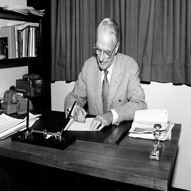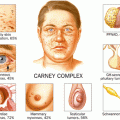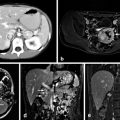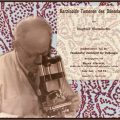Oliver Cope in 1964. (Courtesy of the MGH Archives)
Introduction
Oliver Cope is known to many as one of the fathers of endocrine surgery and for his seminal work on the anatomy and surgical treatment of parathyroid disorders. The “Oliver Cope Meritorious Achievement Award” is the highest honor bestowed upon members of the American Association of Endocrine Surgeons for lifetime achievement in the field, which has only been awarded six times in 30 years. In reality, Oliver Cope’s life and achievements go beyond endocrine surgery and showcase a meticulous surgeon who devoted his entire life to caring for his patients. He has a wide range of achievements related to the surgical practices for burns and breast cancer, as well as diseases of the thyroid and parathyroid glands. This underlines his unique ability to combine detailed biologic and physiologic knowledge with passionate care of patients.
Oliver Cope Early Work
Oliver Cope was born in Germantown, Pennsylvania in 1902. His mother was a pacifist and active in the suffrage movement . She insisted that Oliver learn multiple languages and forbade the use of English at the dinner table. She also wanted him to pursue music, and he played the fiddle almost every day of his life. His father was a Quaker architect and the tenets of this religion, including simple living, permeated Oliver Cope’s entire life. He attended Haverford College for 1 year before transferring to Harvard University, where he majored in chemistry. In college, he was involved with the Glee club and the Liberal Club where he led a successful campaign to admit Jewish students to Harvard. Along the way, he developed a deep interest in medicine and was admitted to Harvard Medical School. During his second year of medical school, he travelled to China where he worked as a news correspondent and interestingly was the first westerner to interview Chiang Kai-Shek, which he did in secret in 1924 [1] .
After his graduation, he became a surgical resident at the Massachusetts General Hospital (MGH) in 1928. He arrived at MGH during a remarkable transformation of the American surgical scene. Around this time, MGH had begun a “full time” surgical service propelled by Edward P. Richardson to do research, which meant that surgeons joining would have full-time appointments at Harvard Medical School, yet they would retain the ability to be in private practice. This fusion of practice and research allowed a deepening of the investigative work performed by surgeons, especially since a modest monetary support was provided [2] (Fig. 1).

Fig. 1
Oliver Cope at work at the Massachusetts General Hospital. (Courtesy of the MGH Archives)
During his time as a resident, he clearly impressed the surgical staff and was named administrative assistant to Dr. Edward D. Churchill, who became the chief of The West Service at MGH in 1931 and later chief of surgery. Dr. Churchill’s assignment as chief was critical to Oliver Cope’s transformation into a surgeon–scientist; Dr. Churchill believed “that integration of research oriented full time staff” was necessary to allow a depth of understanding of surgical diseases that did not exist prior to that in Boston. This was also when the concept of “surgical specialization” was developed, which went against the more prominent concept among other surgical leaders of the time: the general surgeon. Dr. Churchill’s general concept was that, as chief of surgery, he could see the landscape and needs of the department and the field of surgery better than most . He would then assign the most pressing issues to be addressed to his most promising surgical staff and residents. Dr. Churchill’s mandate that each faculty study one or two areas was supplemented by monetary support. Oliver Cope was assigned to work on burns and then parathyroid disorders where knowledge was still sparse when he began his research [2].
Dr. Cope had shown himself to be driven and exceptionally bright. He spoke multiple languages fluently including German and French, thus in 1933, he was chosen as The Moseley Traveling Fellow at MGH. He embarked on a trip to Europe to study the pathophysiology of the endocrine glands with Ludwig Pick in Berlin and then with Sir Henry Dale in London the following year [1] .
Cope’s Work on Parathyroid Disorders
Cope’s work on parathyroid disorders is truly a testament to his meticulous nature and remarkable ability to insightfully tie together vast amounts of information from a minute amount of clinical material. During the time he was putting together a mental story about the diagnosis and surgical treatment of hyperparathyroidism, it was quite difficult to even read the works of others on the subject. Ivar Sandstrom first described the parathyroid glands in Uppsala, Sweden, as a medical student in 1880. The work was published in Swedish and barely noticed elsewhere, until study of its function began in the 1890s, and surgeons started focusing on preserving the parathyroid glands during thyroid surgery as a way to prevent tetany. Hyperparathyroidism was first described in 1925, and was basically thought to be a disease caused by a single enlarged gland or “adenoma” and that removal of this adenoma would result in a cure of the condition. The exact relation of the bony disease to the parathyroid gland was not yet understood.
In July of 1925, Dr. Mandl in Vienna treated Albert J. Herr who was suffering from advanced osteitis fibrosa (also known then as von Reckinghausen’s disease) with parathyroid extract. When that failed to improve things, Mandl actually grafted fresh parathyroid tissue from a victim of a streetcar accident, which significantly worsened the patient’s bone loss and increased calcium levels in his urine. Dr. Mandl then performed a neck exploration and removed a 21-mm parathyroid gland, which resulted in rapid clearing of urinary calcium and improved bone health. Simultaneously in the USA, a team of medical doctors at MGH were using parathyroid hormone (PTH) in the form of parathyroid extract, to treat lead poisoning, and they noted the effects on the bones. Dr. Aub, a physician in New York City (NYC) whose laboratory Dr. Cope had worked in, noted a similar bone disease in the sea captain Charles Martell who had lost 7 in of height rapidly. Aub referred him to Boston where it was confirmed that his calcium metabolism resembled what had been seen in the lead poisoning patients treated with PTH extract. This patient was then referred to the chief of surgery at MGH, Edward Richardson, who without any knowledge of Mandl’s work in Vienna performed two operations in the neck where he was only able to find and remove normal parathyroid tissue. By 1931, there had been some more activity on both sides of the Atlantic, and the British surgeons Walton and Hunter had removed a handful of parathyroid adenomas from patients’ necks and one from the mediastinum. In 1931, Dr. Churchill, who had by then become the chief of surgery at MGH, was asked to reoperate on Charles Martell who had one more unsuccessful operation in NYC (right thyroid lobectomy) in the meantime [3]. Four additional patients also diagnosed with hyperparathryoidism were also hospitalized at MGH by the medical service and were awaiting surgical cure. Dr. Churchill recognized he had already performed one successful operation, yet many other good surgeons had failed, and his future success would depend on
the ability of the surgeon to know a parathyroid gland when he saw it and to know the distribution of the glands, where they hide, and also be delicate enough in technique to be able to use his knowledge. [4]
Cope, who was by then a senior surgical resident under Dr. Churchill, was assigned the task of learning about the parathyroids and told simply that he would not “have the privilege of operating on the first patient,” until Churchill was satisfied with his understanding of parathyroid gland anatomy. Cope made quick friends with Dr. Benjamin Castleman, a resident in pathology at the MGH, and together they performed 30 postmortem exams of the neck and mediastinum. They microscopically examined every “little piece of fat” to try and tell what was parathyroid. At that time, there was no other person in the pathology department who could recognize these glands. Eventually, they no longer needed to microscopically examine everything because they routinely recognized parathyroid tissue. Shortly after, they recognized the wide anatomic variation and the location of these glands in the thymus and mediastinum. Cope also learned from the pathologist that glands with adenomas might also suffer from hyperplasia and cancer, both of which he was later able to recognize and diagnose. By 1932, Churchill was satisfied with Cope’s understanding of the anatomy of the parathyroids, and he supervised Cope in his first parathyroid operation. Cope found the parathyroid adenoma successfully in his first operation, but he was scolded by Churchill for being “too rough,” as well as leaving “the field too bloody” from using the wrong scissors and instruments for traction of the thyroid. Cope realized he had been taught to be quick thus far in his residency, but now he had to learn to slow down and be more precise for this particular type of surgery to be successful. Cope then performed two other operations; by his third operation, Churchill was finally satisfied with his new work ethic. By this time, Cope was able to operate independently without Churchill “dropping in” and proceeded with operating on Captain Martell; he performed a total of three more neck operations between June and October of 1932, but he found no parathyroid tissue in the neck of the sea Captain. Dr. Churchill, then satisfied that there was no tumor in the neck, took over in November of 1932, and found the tumor in the anterior mediastinum, removing it with a partial sternal split. Unfortunately, this patient ultimately passed away in December from tetany, larygneal spasm, and renal failure, and was reported as “Case Number 6” in Cope and Churchill’s paper describing the first 30 patients treated at MGH in Annals of Surgery in 1936. Cope reported being very grateful to the lessons that were taught to him by this patient [4].
Stay updated, free articles. Join our Telegram channel

Full access? Get Clinical Tree







